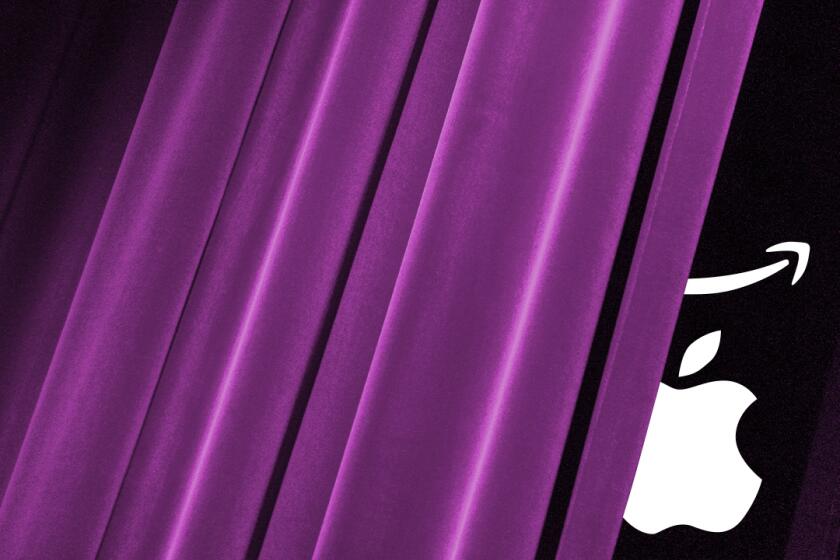MoviePass died. But this movie theater subscription service hit a milestone

- Share via
It has been less than three years since MoviePass shut down after overturning the cinema business with its discount ticketing service, a disruptive saga that now looks quaint compared with the havoc wreaked on multiplexes by the COVID-19 pandemic.
Turns out, offering customers unlimited movie tickets for less than $10 a month was not sustainable.
Yet the subscription services that cinema companies launched amid MoviePass’ rapid rise and subsequent death spiral have proved popular as Hollywood films return to the big screen.
Cinemark, one of the nation’s three largest theater chains, on Wednesday said its $10-a-month Movie Club subscription offering now has 1 million active members, marking a significant milestone for the Plano, Texas-based company. It has more than 3,000 members per theater across its U.S. circuit.
Theaters have reason to be optimistic for the first time in a while. Thank movies like ‘Top Gun: Maverick.’
Cinemark was just one of many chains that launched subscription programs and beefed up their loyalty clubs to combat long-term declines in U.S. moviegoing. Movie Club subscribers receive one 2-D ticket credit a month with the option to pay extra for premium formats such as XD and Imax. Unused ticket credits roll over. Members also get discounts on concessions and avoid online ticketing fees.
AMC’s Stubs A-List, which debuted in 2018, charges $19.95 a month or more, depending on location, to let patrons see up to three movies a week. Regal Unlimited’s plan, which lets people go to as many screenings as they want, starts at $18 a month. AMC Chief Executive Adam Aron said in February 2020 that the company had between 900,000 and 1 million A-List subscribers.
The hope is that subscriptions can help spur admissions as movie theaters recover from the pandemic doldrums.
A big test for the industry is getting underway as the summer movie season kicks off. Paramount Pictures and Skydance Media’s “Top Gun: Maverick” opened with $156 million in the U.S. and Canada over Memorial Day weekend, boosting optimism for the return of the box office despite the growth of streaming. Exhibitors hope big-budget films like “Jurassic World: Dominion,” “Minions: The Rise of Gru” and “Lightyear” build momentum.
Inside the business of entertainment
The Wide Shot brings you news, analysis and insights on everything from streaming wars to production — and what it all means for the future.
You may occasionally receive promotional content from the Los Angeles Times.
The timing is working out for Cinemark’s president and chief executive, Sean Gamble, who at the beginning of this year succeeded Mark Zoradi, a former Walt Disney Co. executive who ran the chain for six years.
In its embrace of the multiverse via “Spider-Man,” “Doctor Strange” and “Everything Everywhere All at Once,” Hollywood has found a new cheat code for sustaining franchises.
The financial situation is improving for theaters, but the business has not yet returned to profitability. Cinemark posted a first-quarter loss of $74 million, though that was an improvement from its loss of $208.3 million during the same quarter a year ago. Cinemark operates 520 theaters in 42 states along with 15 countries in South and Central America.
The Times spoke with Gamble, 47, about the future of subscriptions, the tepidly improving health of the box office and the possibility of more theatrical movies from streaming services, including Netflix. This conversation was edited for length and clarity.
Movie Club was first announced in December 2017, well before the pandemic, when everyone was trying to figure out what their subscription services-slash-loyalty programs were going to look like. What has been the driving force for sign-ups?
The big driver is the overall compelling value that the program provides. Obviously, we hit a short speed bump with COVID, where we paused the program when the pandemic set in, and then we fully reactivated it again last July. Ever since, we continue to see growth each week in new subscribers. It’s got the benefit of not being a use-it-or-lose-it program. The credits you get each month roll over, so even if you don’t go for a month or two or three, it’s still a great program for you.
The tech giants are trying to avoid the fate of other outsiders who’ve entered the film business. By taking it step by step.
How has the program affected attendance?
We’ve seen how Movie Club as a percentage of box office and attendance has grown year after year. In 2019, Movie Club represented about 14% of our box office. As of the first quarter of this year, that’s grown to 20%. Generally, our Movie Club members on average visit theaters three times more than the average moviegoer. We tend to find that once they get into the program, their frequency increases.
Tent pole studio movies like “Top Gun: Maverick” have breathed some life into the box office for older moviegoers who aren’t as interested in comic book movies. Will those customers come back in greater numbers?
Well, we’ve definitely seen improvement. We continue to see that overall comfort in returning to the movies continues to hover at an all time high, and that has improved across all categories of moviegoers. We are still seeing that audiences age 55 and above are still lagging the average, as well as the 15% or so of moviegoers who are still a little bit apprehensive. But what’s really encouraging is that it’s not just the big superhero action films, like the “Spider-Mans” and “Batmans” and “Doctor Stranges,” that have been performing really well.
We’ve seen really successful examples over and over, with films like “The Lost City,” a romantic comedy that grossed $100 million at the domestic box office. We haven’t even had that many of those movies do that pre-pandemic. Then you have an older-skewing movie like “Dog” that does $60 million.
We saw how “Spider-Man: No Way Home” had a big effect. For us, a little over 20% of the audience that came to see “Spider-Man” had not returned to theaters yet. We think “Top Gun” will be a similar type of film for older audiences.
There’s still some hesitancy to return because of the virus, but many people have just gotten out of the habit of going. How do you address that problem?
One of the big things that will help with that is a more regular release of films. We’re still in a mode of a compelling film coming out, and then there’s a lull. It’s been a lot of start-and-stop. As we get into the summer, for the first time, we’re going to have more of a regular cadence of movies coming out every week. There needs to be that steady stream.
As far as what we in exhibition can specifically do, clearly, it all starts with providing an exceptional experience with consumers so when they come to our theaters they want to come back for more. We’ve been very proactive in enhancing our marketing capabilities to get to customers when they’re thinking about what they want to do for the weekend. And then of course we have our various loyalty programs like Movie Club. When we get people into those clubs, it furthers that communication to keep people coming back.
Are you looking at acquiring new locations as theaters close down and change hands? In the L.A. market, there’s been a real musical chairs of theaters closing and changing hands.
We were very fortunate coming into the pandemic that we had a strong balance sheet, and that has clearly benefited us. As we come out the other side, we’re in a very strong position relative to our peers. Specific to M&A [mergers and acquisitions], it’s something we do actively look at. We tend to be pretty picky, disciplined buyers. That is sometimes a little challenging, just because expectations of value, particularly from the seller’s side, may be a little bit different than the risk profile at this moment. If anything, there’s perhaps been fewer opportunities that have come to the market than we may have originally expected.
There’s a reason some of those locations went dark in the first place.
Some would be attractive for the right type of deal. How much money has to be pumped into it to get it into the right shape after whatever you pay to acquire it? That all goes into the calculus of the investment costs. And then what do we think it can actually generate going forward in terms of cash flow?
Are you investing in improving the theaters you already own? If patrons come back and have a bad experience, they’ll stay home.
I couldn’t agree more. We were fortunate again that we were very active in recliner seating before the pandemic. We now have over 65% of our domestic circuit reclined, and we’re continuing to look at new recliner opportunities. We’ve actually seen that our recliner theaters are the ones that have recovered most quickly coming out of the pandemic. Premium amenities have been over-indexing significantly since moviegoing has been picking up again. Premium large-format XD screens are now representing about 14% of our box office while only being about 4% of our screens.
Will the U.S. box office return to pre-pandemic levels? If so, when?
I wish I had a crystal ball. I certainly think it has the potential to get back to that level. I think it is perhaps a little bit more of a moving target over the next year or two, maybe even three. It feels like we’re getting closer and closer but never want to get too cocky when it comes to predicting COVID. Another big piece is just the volume of content affected by COVID.
There has also been an impact from streaming, with certain films being pulled to serve as a marketing tactic to drive new consumer acquisition. I tend to think that is going to normalize over time. We’re hearing from multiple studios that the movies they’re releasing theatrically are performing better on their streaming platforms.
A lot of people have speculated that streaming services would start to more fully embrace theatrical releases, especially with the recent struggles of Netflix. How real are those conversations?
They’re very real conversations, and I think there’s genuine interest. Releasing movies theatrically is very important within the creative community. So as the companies are getting into larger, more compelling commercial films, having a theatrical release is also a way to attract top talent.
Maybe for a while that didn’t matter, because some growth was just naturally happening. But as there’s a lot more competition in the streaming space, there’s more of a need to differentiate and promote greater awareness and have more of that quality product.
That’s always been the value that theatrical has provided to films. It is a very real opportunity on both fronts. In some ways, there’s been a false narrative painted in the media about streaming versus theatrical, as if it’s one or the other. The reality is, it’s all about maximizing the value of films.
More to Read
Inside the business of entertainment
The Wide Shot brings you news, analysis and insights on everything from streaming wars to production — and what it all means for the future.
You may occasionally receive promotional content from the Los Angeles Times.














